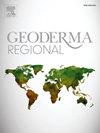Investigating soil properties influencing the depth and degree of lessivage in Florida soils using a random forest modeling approach
IF 3.3
2区 农林科学
Q2 SOIL SCIENCE
引用次数: 0
Abstract
The translocation of clay sized particles is an extensive soil process that occurs in over half of the total surface area covered by soil globally. However, investigations into lessivage are usually limited in extent and scale, and results from experimental data do not reflect natural conditions since control is exerted on various soil properties, such as particle size distributions, and clay mineralogy. Using the NCSS Soil Characterization Database and the USDA Soil Taxonomy definition for an argillic horizon, a random forest machine learning approach was used to investigate lessivage in Florida soils. Within the database, 395 soil profiles observed and described in Florida were identified to have an argillic horizon and lack the presence of a lithologic discontinuity. The coefficient of determination (R2), and the root mean square error (RMSE) were used to estimate the performance of the random forest model. The validation results showed that the model for the depth of lessivage achieved an R2 of 0.59 ± 0.07 and an RMSE of 27.86 ± 2.62 cm and the model for the degree of lessivage achieved an R2 of 0.68 ± 0.14 and an RMSE of 5.91 ± 3.25. A variable importance analysis indicated that the concentration of OC, the CEC, and the total extractable bases in the eluvial zone were the dominant soil properties in predicting the depth of the argillic horizon. The response in the predicted depth to the argillic horizon was similar with each of the aforementioned correlated variables and indicative of the flocculating mechanism, whereby polyvalent cations anchor OM to particle surfaces which then enables particle bridging. Whereas, extractable acidity in the eluvial zone and sand concentration in the illuvial zone were the dominant soil properties in predicting the degree of lessivage. As extractable acidity in the eluvial zone increased, the degree of lessivage decreased which could be indicative of coagulation due to an increase in the activity of Al3+ and H+ ions. Another mechanism identified in clay immobilization in this study is the cessation of the wetting front as a result of the loss of energy. As the depth to gleying increased, the predicted depth to the argillic horizon increased and the degree of lessivage increased. However, based on the variable importance analysis, this mechanism was not determined to be dominant in Florida soils.
利用随机森林模型方法研究影响佛罗里达土壤退化深度和程度的土壤特性
粘土颗粒的移位是一个广泛的土壤过程,发生在全球土壤覆盖的总表面积的一半以上。然而,对土壤退化的研究通常在程度和规模上是有限的,并且实验数据的结果不能反映自然条件,因为控制施加于各种土壤性质,如粒度分布和粘土矿物。利用NCSS土壤特征数据库和美国农业部土壤分类定义的泥质层,随机森林机器学习方法用于调查佛罗里达州土壤的退化。在该数据库中,在佛罗里达州观察和描述的395个土壤剖面被确定为具有泥质层,缺乏岩性不连续的存在。使用决定系数(R2)和均方根误差(RMSE)来估计随机森林模型的性能。验证结果表明,缺失深度模型的R2为0.59±0.07,RMSE为27.86±2.62 cm;缺失程度模型的R2为0.68±0.14,RMSE为5.91±3.25。变量重要度分析表明,在预测泥质层深度时,有机质浓度、CEC浓度和总可提取碱是主要的土壤性质。预测深度对胶凝层的响应与上述相关变量相似,表明絮凝机制,即多价阳离子将OM锚定在颗粒表面,从而实现颗粒桥接。而淋积带的可提取酸度和淋积带的沙粒浓度是预测土壤退化程度的主要土壤性质。随着淋积带可萃取酸度的增加,减少的程度降低,这可能是由于Al3+和H+离子活性的增加而引起的凝血。在本研究中确定的粘土固定的另一个机制是由于能量损失而导致湿润锋的停止。随着泥质层深度的增加,预测泥质层深度增大,减少程度增大。然而,根据变量重要性分析,这一机制在佛罗里达州土壤中并不占主导地位。
本文章由计算机程序翻译,如有差异,请以英文原文为准。
求助全文
约1分钟内获得全文
求助全文
来源期刊

Geoderma Regional
Agricultural and Biological Sciences-Soil Science
CiteScore
6.10
自引率
7.30%
发文量
122
审稿时长
76 days
期刊介绍:
Global issues require studies and solutions on national and regional levels. Geoderma Regional focuses on studies that increase understanding and advance our scientific knowledge of soils in all regions of the world. The journal embraces every aspect of soil science and welcomes reviews of regional progress.
 求助内容:
求助内容: 应助结果提醒方式:
应助结果提醒方式:


